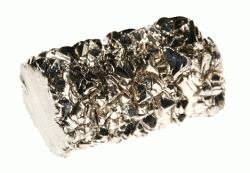Titanium

original size 2.5 x 4 cm, 87 grams
courtesy of www.images-of-elements.com
Titanium is used in steel as an alloying element to reduce grain size and of course as a deoxidizer. In nature it does not occur in pure it is primarily in the minerals anatase, brookite, ilementie, perovskite, rutile and titanite. About 1945-1950, when firstly it was possible to produce titanium commercially there was hardly found an application for it. Titanium for a certain time was considered a laboratory curiosity.
The element is light-weight and twice as strong as aluminium, non-corrosive and withstand high temperatures. It has a melting point at about 1.800°C. Light-weight, heat-resistant and strength made it to an important compound for airplane and all kinds of space vehicles. Another field of application is medicine. Titanium is nontoxic, non-corrosive and therefore quite often used for implants like artificial hip joints, screws and parts of pacemakers. Titanium alloys compete with aluminium, nickel and ferrous alloy. Because of its strength to weight ratio and its high melting point it is the material of choice for engine parts that have to operate under heat conditions up to 600°C.
Other applications are: ship propellers, consumer products for marine, parts of power generators, engines, dental implants and many more. Titanium dioxide (TiO2) is a white powder and widely used for paints substituting lead.
The manufacturing process to obtain commercial pure titanium is achieved through the Kroll process. The process is described at www.titaniumexposed.com as follows: "... This is achieved through the Kroll process, by converting titanium dioxide bearing titanium ore into chloride thus creating titanium chlorides. These are chemicals separated through a process called fractional distillation, with the final product being a porous mass of titanium metal mixed with byproducts, known as titanium sponge. This sponge is then subjected to leaching or heated vacuum distillation to remove further impurities."
